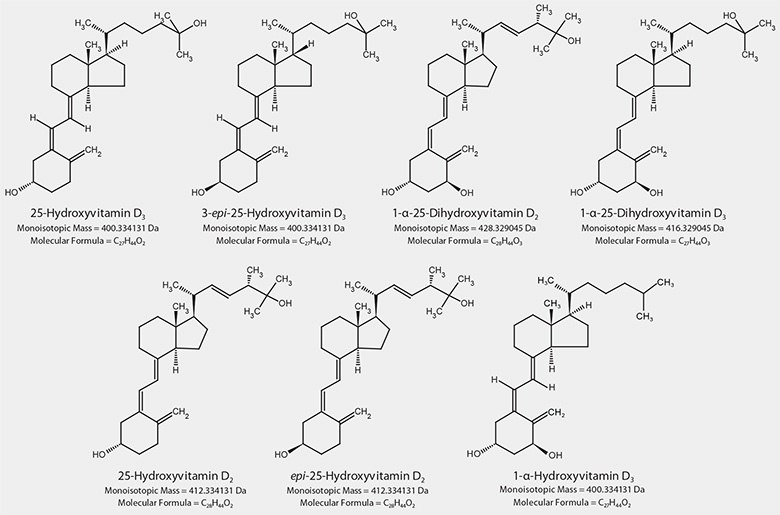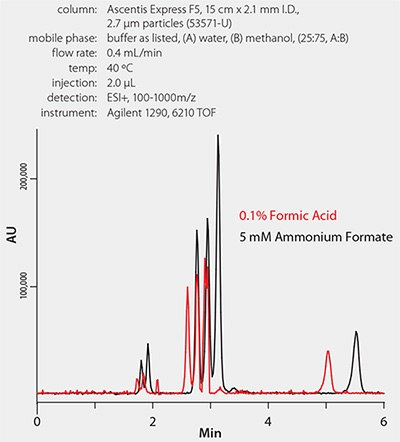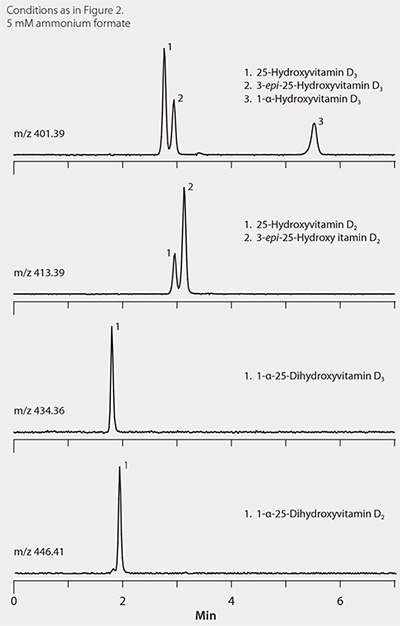Method Optimization for LC-MS Analysis of Vitamin D Metabolite Critical Pairs in Serum
Craig Aurand, Hugh Cramer
Integrated Sample Preparation and Advanced Sample Preparation Technologies
Using HybridSPE®-Phospholipid, Ascentis® Express, and Other LC-MS Workflow Components
The unique combination of column selectivity using Ascentis® Express F5 and phospholipid removal using HybridSPE®-PLus provides a robust and accurate LC-MS method for accurate and sensitive analysis of vitamin D metabolites, including isobaric critical pairs.
Introduction: Interest in Vitamin D
Analysis of vitamin D metabolites has continued to be a topic of interest in recent publications, primarily as biomarkers for possible disease states and vitamin deficiency. While vitamin D is present in two forms, vitamin D3 and vitamin D2, current ELISA methods demonstrate different cross-reactivities and cannot distinguish between D2 and D3 forms of the vitamin metabolites resulting in erroneous reporting of total 25-hydroxyvitamin D concentrations. Further, there is interest in an analytical means to differentiate the D2 and D3 forms from the D2 and D3 epimers because of their different degrees of bioactivity.
Study Aim and Overview
In this study, chromatographic screening studies for the analysis of vitamin D metabolites were expanded to include dihydroxymetabolites along with 25-epi-homologs (Figure 1). Screening consisted of evaluating various column stationary phases, organic modifiers and buffers for the resolution of critical pair isobaric compounds. The goal was to develop chromatographic conditions for the quantitation of hydroxy and dihydroxy vitamin D2 and D3 metabolites, including the isobaric epimers, from human serum samples. In addition to chromatographic method optimization, sample preparation techniques were evaluated to determine the impact of biological matrix on the sensitivity and accuracy of the LC-MS method.

Figure 1. Structures of Vitamin D Metabolites
Analytical Challenges with Vitamin D Metabolites
The particular difficulty in vitamin D metabolite analysis is the differentiation between the epimer isoform of the D2 and D3 metabolites. The epimers are isobaric to the D2 and D3 metabolites rendering them indistinguishable in the MS and thus requiring chromatographic separation to resolve them.
Chromatographic Method Development
Traditional reversed-phase chemistries, e.g., C18, do not resolve the critical epimeric pairs of vitamin D metabolites. Therefore, the initial phase of chromatographic method development consisted of screening Ascentis® Express cyano, phenyl hexyl and pentafluorophenyl (F5) stationary phases for the efficient resolution of 1-α-25-dihydroxyvitamin D3, 1-α-25-dihydroxyvitamin D2, 25-hydroxyvitamin D3, 25-hydroxyvitamin D2, 3-epi-25-hydroxyvitamin D3, 3-epi-25-hydroxyvitamin D2 and 1-α-hydroxyvitamin D3. Gradient elution was conducted using several organic modifiers (Table 1). Initial organic modifier concentrations were adjusted to provide equivalent eluotropic strength.
The column screening criteria was used to determine which stationary phase/organic modifier combination produced the highest resolution of the critical isobaric pairs 25-hydroxyvitamin D2 and epi-25-hydroxyvitamin D2 (observed mass m/z 413.33) and 25-hydroxyvitamin D3 and epi-25-hydroxyvitamin D3 (observed mass m/z 401.33). Table 2 presents the minimum resolution table of these isobaric pairs. Results indicated that methanol produced the highest resolution between isobaric pairs on all stationary phases compared to acetonitrile and ethanol. While both the cyano and F5 stationary phases demonstrated some resolution of the isobaric pairs, baseline resolution was only achieved on the F5.
Note: Minimum resolution is defined as resolution between two sets of isobaric compounds
25-hydroxyvitamin D2 and epi-25-hydroxyvitamin D2, 413.33 m/z
25-hydroxyvitamin D3 and dpi-25-hydroxyvitamin D3, 401.33 m/z
Sensitivity Optimization and Buffer Selection
The second phase of the study focused on conversion of the optimum screening method into an isocratic method that could ultimately be used for the analysis of human serum samples. The F5 column was selected based on its ability to provide the highest minimum resolution of isobaric pairs using methanol as the organic modifier in the mobile phase. At this stage, the impact of the buffer modifier was evaluated for the analyte responses. Because the vitamin D metabolites are neutral compounds, it was anticipated that the buffer would have minimal impact on selectivity, although it might impact ionization in the LC-MS source.
Figure 2 and Table 3 demonstrate the impact of mobile phase buffer on the ionization of the vitamin D metabolites when a 300 ng/mL standard of vitamin D metabolites is injected onto the F5 column. Figure 2 depicts the full scan comparison of analyte response differences between analysis conducted using the ammonium formate buffer and the formic acid modified mobile phase. As can be observed in Table 3, using ammonium formate as the mobile phase buffer nearly doubles the response of the vitamin D metabolites over the formic acid additive. The final optimized chromatographic method using ammonium formate buffer and the Ascentis® Express F5 stationary phase is shown in Figure 3. Note that baseline resolution of isobaric vitamin D metabolites is achieved in less than 6 minutes.
Figure 2. Comparison of Buffer Effect on Vitamin D Metabolite Response on Ascentis® Express F5

Figure 2.Comparison of Buffer Effect on Vitamin D Metabolite Response on Ascentis® Express F5

Figure 3. Separation of Vitamin D Metabolites on Ascentis® Express F5
Comparison of Sample Prep Techniques to Reduce Serum Matrix Effect
The final phase of the study involved implementing the optimized chromatographic method for the analysis of spiked human serum samples. Particular attention was paid toward sample preparation and its impact on analytical results. Serum sample preparation requires protein precipitation with organic solvents or strong acids. This approach results in gross depletion of proteins from the sample, but leaves high levels of matrix interference from coextracted phospholipids. Coextracted phospholipids can cause quantitative irregularities and decrease sample throughput due to gradient column washing requirements.
Human serum samples were spiked with vitamin D metabolites and processed using two sample preparation techniques: standard protein precipitation alone and standard protein precipitation followed by phospholipid depletion with HybridSPE®-PLus plates. (Note that protein precipitation can also be performed directly in the HybridSPE® plates for a truly one-step sample prep method. However, users may prefer to carry out the protein precipitation as a separate step.) Results obtained from sample processed using the two sample preparation techniques were evaluated to determine analytical impact of phospholipid matrix interferences, both in terms of chromatographic overlap and impact on analyte response.
Sample Prep Methodologies
Human serum samples were spiked at 25 ng/mL with vitamin D metabolites. Protein precipitation was performed offline by adding 100 μL of spiked serum followed by 300 μL of 1% formic acid acetonitrile to a 96-well collection plate. Samples were thoroughly mixed by performing five 300 μL draw/dispense cycles using a digital pipette. Samples were then left to sit for 5 minutes before transferring 200 μL of the resulting supernatant into a HybridSPE® PLus 96-well plate. Samples were passed through the HybridSPE® PLus plate by applying 10” Hg vacuum for 4 minutes and analyzing the resulting filtrate directly. As a comparison, spiked human serum was also processed using standard protein precipitation alone by adding 100 μL of serum followed by 300 μL of 1% formic acid acetonitrile into 2 mL centrifuge vials. Samples were then vortexed and centrifuged, and the resulting supernatant was analyzed directly.
Improved Analyte Response after Phospholipid Removal
Figure 4 depicts the phospholipid selected ion chromatograms from samples processed via standard protein precipitation (red trace) and samples processed using the HybridSPE®-PLus plate (black trace). A significant amount of phospholipid matrix from samples processed via protein precipitation alone was observed eluting in the 2–4 minute window where several vitamin D metabolites also elute. Conversely, samples processed by the HybridSPE®-PLus plate displayed no detectable phospholipid matrix. Phospholipid coelution with analytes of interest has the potential to cause sensitivity and reproducibility issues resulting in irregularities in quantitation. Table 4 compares analyte recovery of the two sample preparation techniques. The direct overlap in the elution windows of vitamin D metabolites and the phospholipid matrix interference for samples processed with standard protein precipitation resulted in a 40% reduction in signal response for several of the metabolites. As a result, samples processed using the HybridSPE®-PLus plate, which demonstrated no co-eluting matrix interference, demonstrated a higher analyte response.

Figure 4. Phospholipid Matrix Monitoring (selected ion)
Summary
Chromatographic resolution still plays an important role in LC-MS applications when dealing with isobaric compounds. The unique selectivity of the Ascentis® Express F5 column gave a fast and efficient analytical method for 25-hydroxyvitamin D and related forms from serum samples. In addition, phospholipid depletion using the HybridSPE®-PLus 96-well plate enabled efficient sample cleanup increasing method reproducibility and accuracy. As demonstrated in this study, this novel sample prep technique coupled with the unique selectivity of the Ascentis® Express F5 column enables a fast and simplified bioanalytical method for associated vitamin D metabolites. Likewise, this approach demonstrates how selectivity, in both chromatographic and sample preparation steps, allows for efficient analysis that would otherwise be unattainable with traditional reversed-phase approaches.
Materials
To continue reading please sign in or create an account.
Don't Have An Account?